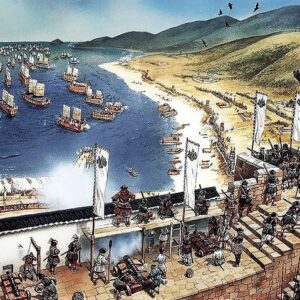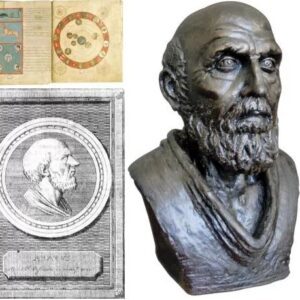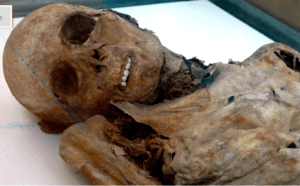
During the 17th century, a striking discovery was made in the fortified town of Venzone, Italy, where a number of mummified bodies were found in the chapel’s crypt. However, the method by which the bodies became mummified remained a puzzle. Ever since the corpses were taken out of the crypt, experts in the field of archaeology have been captivated by the natural mummification process that had occurred, yet to this day, it remains an enigma.
The mummies were spotted during construction
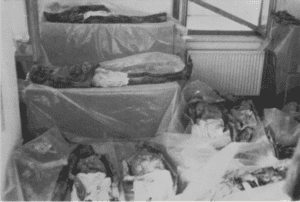
Following the Friuli earthquake of 1976, the Venzone Mummies were moved to a temporary shelter.
In 1647, workers were carrying out renovations on the cathedral of Venzone when they stumbled upon the initial mummy. Their job was to enlarge the 14th-century chapel and they were working in the crypt when they came upon the sepulcher below the ground.
This mummy was in a distinct condition and originated from the 1300s when the tomb was first constructed. The body had no moisture left and the skin had become dry, comparable to parchment paper. It had a weight of roughly 33 pounds and its back was arched, leading it to be called “Gobbo” (which means hunchback). The construction workers couldn’t extract Gobbo carefully and thus left it in place.
More Mummies Were Discovered
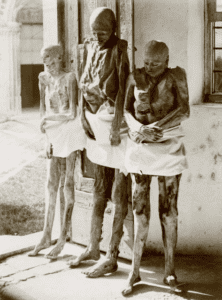
Mummies of Venzone, 14th-19th century, preserved in the crypt of the Chapel of St Michael, Venzone, Friuli-Venezia Giulia, Italy, ca 1910.
Subsequently, additional mummies, amounting to 40 in total, were uncovered in the same crypt. All of them weighed between 22 and 44 pounds and shared the common attribute of being completely dehydrated and conserved. However, it wasn’t until the 19th century that they were retrieved from the tomb and moved above ground. These mummies were transported to various locations, such as the Museum of Vienna, the University Cabinet of Padua, and the Church of the Invalids in Paris.
Out of the 21 mummies originally found in the Upper Chapel, 15 can still be viewed in Venzone. However, in 1976, a powerful earthquake struck the area, causing severe damage to several buildings, including the chapel where the mummies were kept. Unfortunately, six of the mummies were destroyed, while the remaining ones were able to survive and can still be seen in Venzone today, which has since been reconstructed.
How were the mummies so naturally well preserved?

Crypt in the Chapel of St Michael with the Mummies of Venzone, 14th-19th century, crypt in the Chapel of St Michael, Venzone, Friuli-Venezia Giulia, Italy, photograph from Istituto Italiano d’Arti Grafiche, Bergamo, 1910-1913.
ince these bodies were not intentionally mummified, it is believed that the natural mummification process must have taken place. Researchers propose that this process began about a year after their burial, but how it exactly occurred remains a mystery. There are several theories that could explain how these corpses were completely dehydrated yet with their skin remarkably well-preserved.
One theory suggests the presence of an unknown fungus in the crypt where the mummies were found. The fungus was found on the tomb walls and on the mummies’ coffins, and it had the ability to absorb a considerable amount of liquid, indicating that it could have contributed to the drying process. The fungus was named Hypha tombicina after the name of the tomb where it was discovered.
However, some researchers have dismissed this theory, as they think that there wasn’t enough fungus present in the tomb to absorb such a significant amount of liquid and preserve the bodies so perfectly. Alternatively, it has been suggested that the limestone floor of the crypt provided the ideal environment for mummification. It is possible that a combination of both factors contributed to the natural mummification of the bodies.
No More Samples, No Conclusive Answers
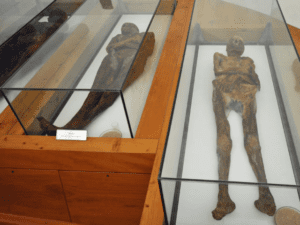
Mummies of Venzone. Preserved in the crypt of the Saint-Michel chapel.
Unfortunately, it doesn’t seem as though a definitive answer will be reached anytime soon. The mummies are important to the people of Venzone, and archaeologists have long been denied any further sampling of their corpses. Religious and personal reasons have prevented those in authority from allowing any kind of meddling with the bodies.
As such, the archaeologists hoping to understand how the mummies were naturally preserved have limited options for their research. They have access to the original samples that were taken during the extraction and transporting of the various mummies, but little can be traced from that. They can also try to replicate the conditions of the crypt where the mummies were found. Unfortunately, this has also proven to be extremely tricky and has not been completed successfully.


